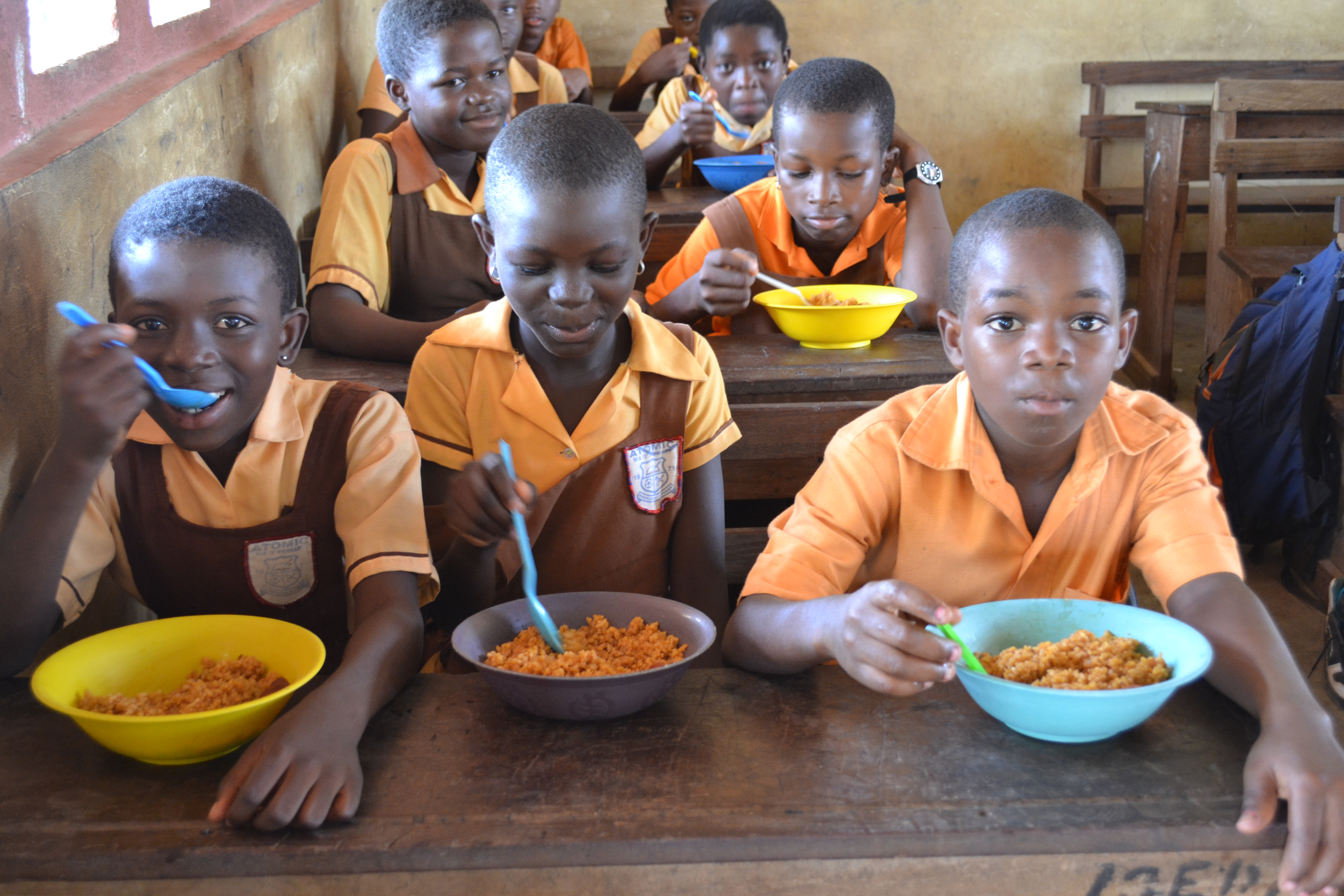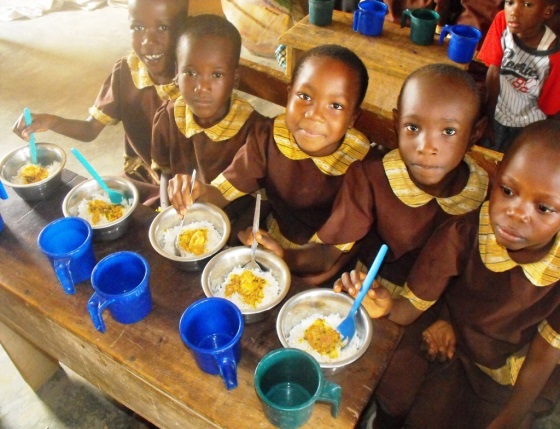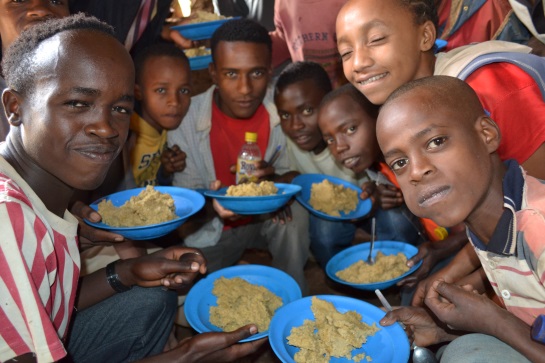Here are some startling facts for you, 368 million school meals are served up every school day and yet 60 million children go to school hungry every school day. At the same time over 44 million children are classed as overweight.
To tackle this issue, countries all over the world are looking at improving the diets of their school children by providing school meals that are fresh, healthy and nutritionally balanced and use locally grown ingredients.
To support this, the
Partnership for Child Development (PCD), Imperial College London, is working with governments in sub-Saharan Africa to develop sustainable school feeding programmes sourced from local farmers. Known as
Home Grown School Feeding programmes, these government-led programmes provide a ‘win-win’ for local communities by providing free nutritious school meals to children while at the same time providing a market for the produce of local farmers.
To celebrate
International School Meals Day, and tying in with theme of “Celebrating culture through food’, PCD has brought together some delicious traditional recipes for school meals, which are being served by schools that are at the forefront of the HGSF movement.

You can prepare your own traditional meal using PCD’s innovative, free to access
online School Meals Planner. The easy to use
School Meals Planner is designed for school caterers around the world to create nutritionally balanced and market-costed meals. The menu planner uses ginger bread mean to show how meals compare with the daily nutritional allowances as recommended by the
World Health Organization. Simply use the
guest login and prepare your own meal!
Ghana
The
Ghana School Feeding Programme provides nutritious hot meals sourced from local farmers to over 1.8 million children every school day. In its work with the Government one of the focus areas has been to see how to improve the nutritional intake of the school children. A key part of this has been through the use of the
School Meals Planner which has enabled menus to be designed using locally available ingredients so that they meet the nutritional needs of the children.
To promote the importance of healthy eating and hygiene local NGOs have been trained to become community-based health and nutrition champions. The Champions use posters, radio jingles and t-shirts to promote heathy eating and good hygiene messages to 400 local communities.
Jollof Rice is one of Ghana’s national dishes and a favourite in schools across the country. Below is an easy-to-follow recipe of this tasty meal.
Jollof rice with fish
|
Ingredients
- 150g rice
- 15g concentrated tomato paste
- 30g anchovy fillets
- 10g onion
- 1g hot red pepper
- 200 ml water
|  |
Method
Add the tomato paste and water to a saucepan and bring to the boil. Sprinkle with chopped onion. Wash rice and add to the tomato mixture. Cook slowly, adding in the anchovy fillets after 10 minutes and stir often during the first 30 minutes, keep tightly covered for a further 20-30 minutes on a very low heat. |
Mali
Mali’s
National School Feeding Programme feeds over 400,000 school children, the value placed on this programme was highlighted by the fact that school feeding continued throughout a violent and drawn out civil war. PCD is working with the government to identify how school feeding can benefit children, local farmers and the wider community.
Tô with baobab leaf sauce
During term time Malian school children enjoy eating Tô, one of Mali’s traditional dishes. This cake-like meal is made from cereal (millet, sorghum or maize) mixed with okra or baobab leaf sauce. Tô is commonly eaten as a sort of porridge and served with fish or meat.
Ingredients
Tô pudding
- 166 g cereal (millet, sorghum or maize) flour
- 550ml water
- Salt
Boabab leaf sauce - 100 g diced meat (beef or lamb)
- 200g Baobab leaf or 4 Okra
- 1-3 tbs pepper
- 1 onion
- 25ml oil
- Chilli pepper (optional)
- Salt
|
|
|
Method to prepare the pudding
Pour 50 ml of water into the flour and stir until a creamy mixture is formed. Bring the remaining water to a simmer and slowly add the flour and salt stirring continuously to obtain a thick, smooth even paste. Cover the pot leave for 5 minutes. Serve hot with the okra or baobab leaf sauce.
Method to prepare the sauce
Blend onion, baobab leaves and pepper until you have a brown paste. Brown off the meat in a pan and add paste. Bake for 20 minutes; and add the chilli 5 minutes before serving. |
Zanzibar
Uji Porridge
During term time children enjoy a traditional tasty “Uji” porridge with orange fleshed sweet potatoes and vegetables.
Ingredients
Uji porridge
- 100 g sorghum flour
- 40 g cowpea flour
- 25 g sugar
- 3 g salt
- Water
Orange Fleshed Sweet potatoes
- 100g potato
- 12g oil
- 500 ml water
Vegetables per child per day
- 25 g spinach/beans/okra
- 12 g oil
- 3 g salt
|  |
Mix the sorghum and cowpea flour in a bowl to make a paste.
Add the flour paste into 100ml of boiling water and stir continuously for 30 minutes. Add the sugar. Add the salt and leave to boil for 2 minutes. Serve hot or warm.
Method for the potatoes
Skin the potatoes and add to saucepan along with the salt and 500ml water and salt. Boil for 45 minutes. Before serving add oil (this helps to absorb the Vitamin A). Serve hot with green vegetables.
|
Nigeria
Steamed Rice with Egusi Stew
A typical meal that children can expect is Steamed Rice with Egusi Stew garnished with Vegetables.
Ingredients
- 600 g of ground Egusi melon seeds
- 15ml red palm oil
- 100g chicken
- 1 Crayfish
- Pepper and Salt to taste
- Large handful of Pumpkin leaves
- 3 stock cubes
|

|
|
Method
Boil chicken for 10 minutes until cooked. Set this aside and heat palm oil in a pan. Once oil is clear, reduce heat and add the ground egusi melon seeds. Fry until the egusi becomes dry then, slowly add the chicken stock.
Cover the pot and cook for 30 minutes. The egusi is done when the oil has risen to the surface and separated from the mix. If this is the case, add the chicken you boiled earlier and season. Finally, add the pumpkin leaves and bring to the boil. Serve with steamed rice. |
Ethiopia
In the Southern Nations and Nationalities Peoples Region of Ethiopia, over 30,000 children are benefiting from a Home Grown School Feeding programme which looks to improve the health and education of the children. As well as serving healthy school meals, the
Enhanced School Health Initiative, looks to provide clean water and hygienic toilets and treats the children for the parasitic worm infections that are common in the area.
Kinche
Kinche is a commonly served breakfast porridge and is one of the three Home Grown School Feeding menus served daily to school children in Ethiopia.
| Ingredients
1 cup cracked wheat 3 cups water 2 tbs of Kibe (spiced clarified butter) Salt to taste
|  |
Method
Bring the water to boil on a medium high heat (you can mix milk with water). Add the cracked wheat, cover the pot and let it cook for 20 minutes or until the water is absorbed. Once cooked, turn off the heat, add the butter and salt to taste while it is still hot and mix in well. |
Now get cooking! You can't learn anything if you're hungry.

